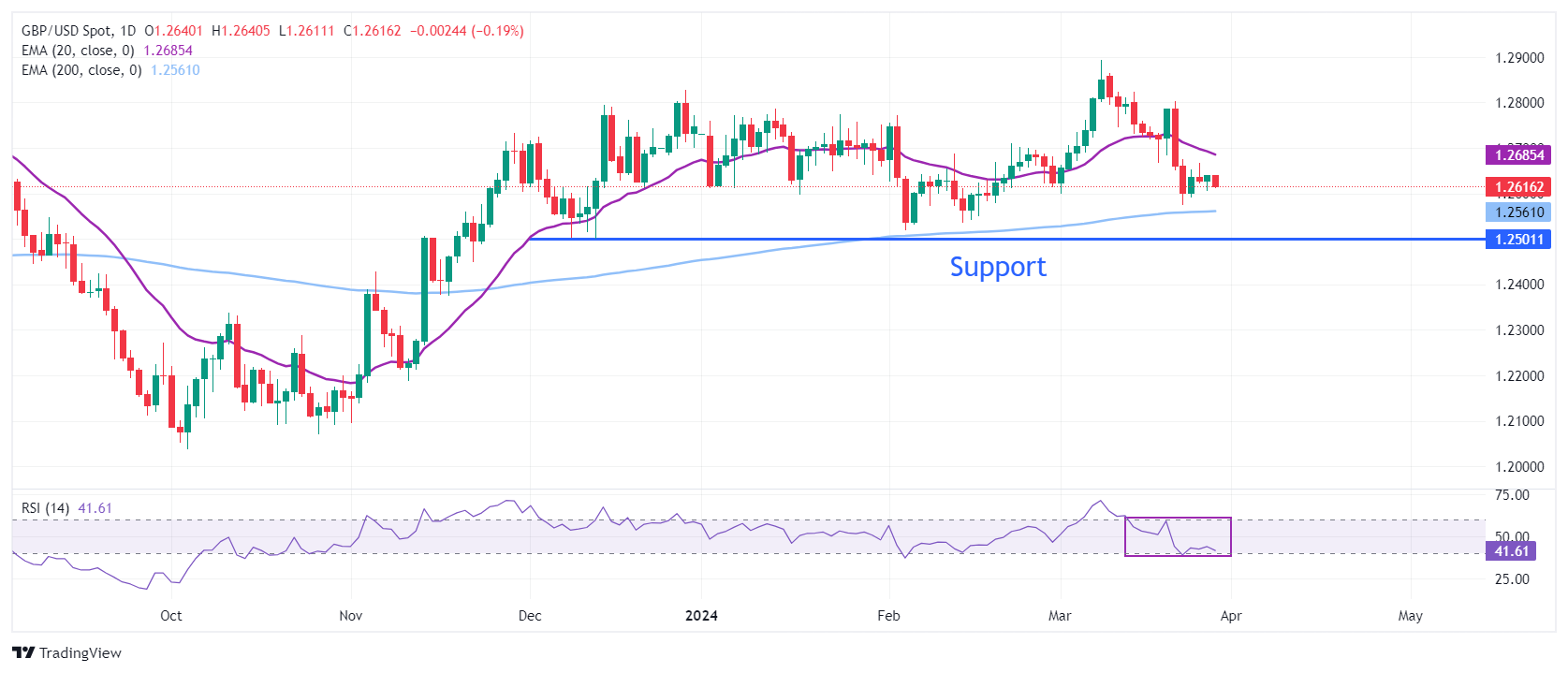- The Pound Sterling falls to 1.2600 against the US Dollar as investors wait for US core PCE inflation data for February.
- The Fed’s preferred inflation gauge could give clues over when the Fed may begin the rate-cut cycle.
- UK’s soft inflation data for February has lifted expectations for BoE rate cuts in June.
The Pound Sterling (GBP) drops to 1.2600 against the US Dollar in Thursday’s London session. More broadly, the GBP/USD pair struggles for direction as investors wait for fresh cues about when the Bank of England (BoE) will begin reducing interest rates. The United Kingdom’s inflation has come down significantly, but BoE policymakers are expected to adopt a cautious approach as early rate cuts could revamp price pressures again.
Investors expect that the BoE will start cutting rates from the June meeting. The expectations have been prompted by sharply easing inflation in February. Also, no BoE policymakers see the need for more rate hikes, indicating that the current level of interest rates is sufficiently restrictive. Generally, the Pound Sterling weakens when investors expect the BoE will start reducing borrowing rates early.
Meanwhile, the UK Office for National Statistics (ONS) released on Thursday its revised Q4 2023 Gross Domestic Product (GDP) estimates, confirming that the economy contracted by 0.3% in the October-December period.
The US Dollar rises ahead of the United States core Personal Consumption Expenditure (PCE) Price Index data for February, which will be published on Friday. The measure, which gauges underlying inflation, is expected to have increased steadily by 2.8% on year.
Daily digest market movers: Pound Sterling slips, but is broadly sideways
- The Pound Sterling consolidates in a tight range slightly above 1.2600 as investors seek fresh guidance on the UK interest-rate outlook. Bank of England policymakers are mixed about rate cuts as Jonathan Haskel said on Wednesday to the Financial Times that rate cuts should be “a long way off.” Haskel further added: “Although the fall in headline inflation is very good news, it is not informative about what we really care about. What we really care about is the persistent and the underlying inflation.”
- The comments from Jonathan Haskel suggest that he has low confidence on progress in inflation declining to 2% and rate cuts are still off the table. On the contrary, BoE Governor Andrew Bailey said in a recent interview with the Financial Times that market expectations for two or three rate cuts this year are not “unreasonable”. Regarding the inflation outlook, Bailey said “We are not seeing a lot of sticky persistence.”
- Currently, market expectations for BoE rate cuts have been brought forward to the June policy meeting from prior anticipation for August after UK inflation softened more than expected in February. Apart from that, the BoE’s slightly dovish outlook on interest rates in last week’s monetary policy statement has boosted expectations for June’s rate cuts.
- Meanwhile, the market sentiment is slightly risk-off as S&P 500 futures trade lower in Thursday’s European session. The US Dollar Index (DXY) rises to 104.40, an inch away from its monthly high of 104.50, amid uncertainty ahead of the United States core PCE Price Index data for February.
Technical Analysis: Pound Sterling trades close to 1.2600

The Pound Sterling trades back and forth in a narrow range around 1.2600. The GBP/USD pair seems vulnerable around 1.2600 as the 20-day Exponential Moving Average (EMA) at 1.2690 has turned down. The asset is slowly declining to the 200-day EMA, which trades around 1.2564. On the downside, the horizontal support from December 8 low at 1.2500 would provide cushion to the Pound Sterling bulls.
The 14-period Relative Strength Index (RSI) slips to near 40.00. A bearish momentum would trigger if the RSI dips below this level.
Risk sentiment FAQs
In the world of financial jargon the two widely used terms “risk-on” and “risk off” refer to the level of risk that investors are willing to stomach during the period referenced. In a “risk-on” market, investors are optimistic about the future and more willing to buy risky assets. In a “risk-off” market investors start to ‘play it safe’ because they are worried about the future, and therefore buy less risky assets that are more certain of bringing a return, even if it is relatively modest.
Typically, during periods of “risk-on”, stock markets will rise, most commodities – except Gold – will also gain in value, since they benefit from a positive growth outlook. The currencies of nations that are heavy commodity exporters strengthen because of increased demand, and Cryptocurrencies rise. In a “risk-off” market, Bonds go up – especially major government Bonds – Gold shines, and safe-haven currencies such as the Japanese Yen, Swiss Franc and US Dollar all benefit.
The Australian Dollar (AUD), the Canadian Dollar (CAD), the New Zealand Dollar (NZD) and minor FX like the Ruble (RUB) and the South African Rand (ZAR), all tend to rise in markets that are “risk-on”. This is because the economies of these currencies are heavily reliant on commodity exports for growth, and commodities tend to rise in price during risk-on periods. This is because investors foresee greater demand for raw materials in the future due to heightened economic activity.
The major currencies that tend to rise during periods of “risk-off” are the US Dollar (USD), the Japanese Yen (JPY) and the Swiss Franc (CHF). The US Dollar, because it is the world’s reserve currency, and because in times of crisis investors buy US government debt, which is seen as safe because the largest economy in the world is unlikely to default. The Yen, from increased demand for Japanese government bonds, because a high proportion are held by domestic investors who are unlikely to dump them – even in a crisis. The Swiss Franc, because strict Swiss banking laws offer investors enhanced capital protection.

























